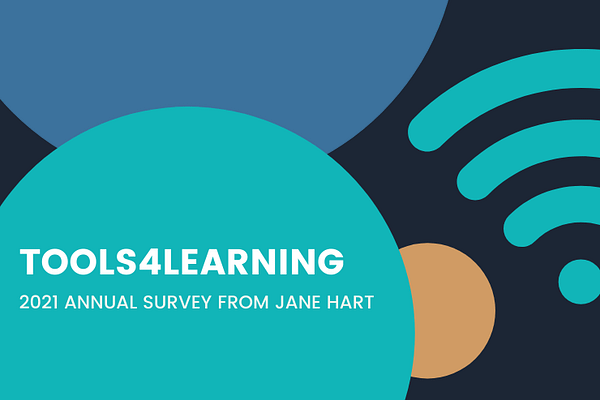
Each year, I look forward to reviewing the results of Jane Hart’s Top 300 Tools for Learning and to submitting my votes for a personal Top Tools for Learning list. I haven’t quite been writing up my list every single year (missed 2020), but I did submit a top 10 list in 2015, 2016, 2017, 2018, 2019, and 2021. I haven’t come across too many others’ 2022 Top Tools for Learning votes, yet, but did enjoy reviewing Mike Taylor’s list.
I avoid looking at the prior year’s lists until I have identified my votes for current year. Once my list was finished for 2022, however, I did compare and realize that I had left Zoom off for this year. Given that I use Zoom pretty much daily for meetings, teaching, speaking engagements, and podcast interviews, I suspect this is one of those things where Zoom has become so integral to my life that it’s become like water that I can’t see because I’m swimming in it.
Something that I am still looking forward to getting more practice with is a technique shared by Kevin Kelly on Episode 406 of the Teaching in Higher Ed podcast. Kevin shared about how to turn a Zoom chat into a useful summary and included a sample summary from an AAEEBL Meetup in the show notes for the episode.
Another thing I realize as I reflect back on the current and prior years of voting is how much every single tool I use fits into a personal knowledge mastery system, which I have learned so much about from Harold Jarche over decades now. Harold Jarche writes:
Personal knowledge mastery is a set of processes, individually constructed, to help each of us make sense of our world and work more effectively. PKM keeps us afloat in a sea of information – guided by professional communities and buoyed by social networks.
PKM is the number one skill set for each of us to make sense of our world, work more effectively, and contribute to society. The PKM framework – Seek > Sense > Share – helps professionals become knowledge catalysts. Today, the best leaders are constant learners.
Harold was on Episode 213 of the Teaching in Higher Ed podcast, if you would like to learn more about PKM. There is also an entire collection of PKM episodes.
My 2022 Top Tools for Learning
Below are my top 10 Tools for Learning for 2022. Jane Hart’s survey methodology has shifted over the years. She now asks us to list each tool and then identify which of three categories we most often use it for: personal learning, workplace learning, or education. Mine overlap quite a bit, within those categories, but I’ve done my best to pick the context in which I use it most often.
1. Overcast | Personal Learning | PKM-Seek
This podcast “catcher” app is a daily part of my life and learning. Overcast received a major design overhaul in March of 2022, which led me to reorganize my podcast playlists to take full advantage of the new features. In October of 2021, I wrote up my podcast favorites, in case you’re interested.
2. Unread | Personal Learning | PKM-Seek
While Overcast is for the spoken word, Unread is primarily for written pieces. Powered by real simple syndication (RSS), Unread presents me headlines of unread stories across all sorts of categories, which I can tap (on my iPad) to read, or scroll past to automatically mark as read. I use Unread in conjunction with Inoreader, which is a robust RSS aggregator that can either be used as an RSS reader, as well, or can be used in conjunction with an RSS reader, such as Unread.
On a related note, if you like the idea of information flowing to you (via RSS) versus you having to go find it – and you like to cook – check out the app Mela. I switched to it in the past year and haven’t looked back.
3. Twitter | Personal Learning | PKM-Seek
I continue to benefit from a strong personal learning network (PLN), which for me is at its most vibrant on Twitter. Whether it’s for something as simple as getting some good tv/movie recommendations when I am under the weather, or for a deeper and more significant purpose of learning from those in the disability community, I find a tangible benefit with almost every visit. Yes, there are also major problems on social media platforms, including Twitter. But for me, the key has been all in who I follow and how I engage in community with others on Twitter.
4. Raindrop | Workplace Learning | PKM-Sense
While the first three tools I mentioned were all about seeking information, Raindrop is all about sense making (in the present and future) for me. It is a digital bookmarking tool. I wrote about how I use Raindrop in late 2020. I continue to see daily benefits with having such a simple-yet-robust way of making sense of all the information coming at me on a daily basis. Raindrop recently added the ability to highlight text on a page you have bookmarked, but I haven’t experimented with that feature much yet. If I want to do something with annotations and highlighting, I tend to gravitate toward Hypothes.is, a social annotation tool.
5. PollEverywhere | Education | PKM-Sense
When I started in a professional career in the early 1990s, I used to work for a computer training company. One regular thing that would happen with less-experienced instructors would be them standing at the front of the class, asking if everyone “got it” or was “with them.” As you can imagine, many times people either didn’t realize that they were lost, or they were too embarrassed to admit it.
Polling tools like PollEverywhere remove the barrier of people not realizing that they don’t understand something, or for those are reluctant to share their confusion publicly. PollEverywhere also has features to support team collaboration, asynchronous and/or synchronous polling, and can integrate with a learning management system (LMS). I primarily use PollEverywhere for formative assessment, allowing people to respond anonymously to the questions being posed. I subscribe to the Present plan, which allows me to have up to 700 people responding at one time on a given poll question. People in an education context who needed to create reports and access archived poll responses would likely need to go with an Individual Instructor premium account, or department/university-wide plan.
6. Padlet | Education | PKM-Sense
One of many collaborative tools I enjoy using is Padlet, a virtual cork board. I use Padlet to create a shared vision for a class or a team, to create a crowd-sourced music playlist for an event or class, as a parking lot, and to collectively come up with ways to extend learning. This year for our faculty gathering, we have Padlet boards for virtual collaboration and have also printed out posters (with QR codes that point back to the Padlet boards) that people can respond in person to using sticky notes. I love the blend of the analog and the digital that is possible using this approach.
7. Loom | Education | PKM-Share
The past couple of years, Loom has become a part of my daily computing life. It is a simple screen casting tool. Record what’s on your screen (with or without your face included via your web cam) and as soon as you press stop, there’s a link that automatically gets copied to your computer’s clipboard which is now ready to paste anywhere you want. I use Loom for simple explanations, to have asynchronous conversations with colleagues and students, to record how-to videos, and to invite students to share what they’re learning. If you verify your Loom account as an educator, you get the pro features for free.
8. Canva | Workplace Learning | PKM-Share
My use of the graphic design website Canva has evolved over the years. I started by using it to create graphics and printable signs for classes. Now I also use it to create presentations (which can include embedded content, slides, videos, etc.). As I just revisited Canva features in writing this past, I discovered even more things I wasn’t even aware that Canva can do.
I find the pro version worthwhile for both work and for Teaching in Higher Ed, as having the ability to include an entire team of people and have everyone be able to access a brand kit(s) to achieve consistent colors, logos, and other brand assets is a game-changer. We haven’t experimented as much with branded templates or comments and sharing, but there’s so much to benefit from with Canva working collaboratively. The free plan is also quite generous and worth signing up for, even if you don’t wind up upgrading to Pro or Canva for Teams.
9. WordPress | Workplace Learning | PKM-Share
The Teaching in Higher Ed website has been on a hosted WordPress site for so long, I can’t even remember where it resided prior to WordPress. My friend and web developer, Naomi Kasa, has helped keep the site beautiful and functional. One of my favorite features of the site is the page Naomi created with all my upcoming and past speaking engagements. It is great having all that information in one place and to see the collection of resources keep growing over time. Take a look at my resources page for a recent speaking engagement and how I embedded a Canva presentation, which includes use of embedded content and video.
10. Blubrry | Workplace Learning | PKM-Share
If you are going to have a podcast and you want to efficiently and effectively get it released to the majority of the various podcast players, you are going to need a podcast hosting company. We have used Blubrry for years now and appreciate its reliability, ease of use, and integration with WordPress.
Your Turn
Would you like to submit a vote with your Top Tools for Learning? You can fill out a form, write a blog post, or even share your picks on Twitter. The 2022 voting will continue through Thursday, August 25 and the results will be posted by Tuesday, August 30, 2022.



